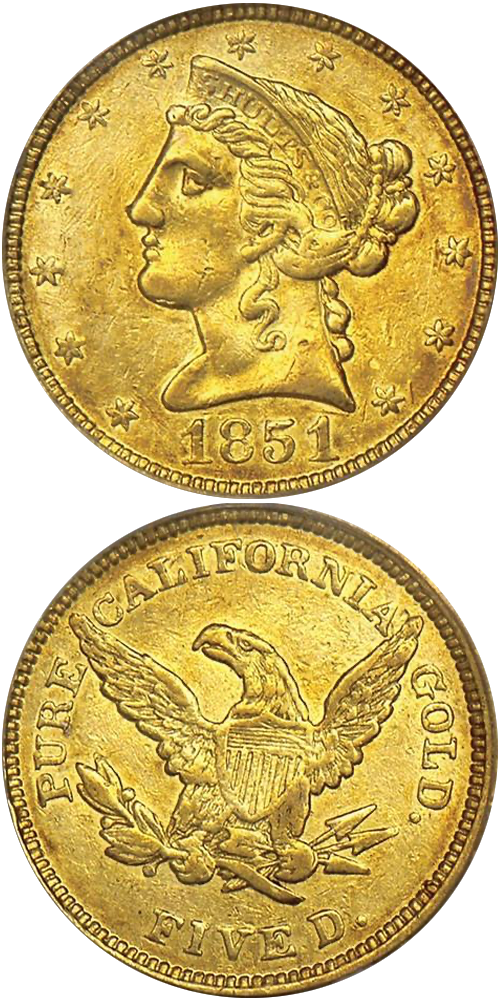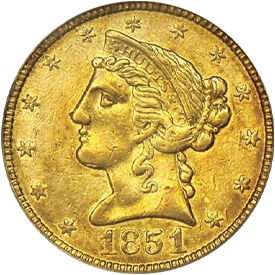Half eagles were struck in 1851 by the firm of Schultz & Co. (sometimes spelled Shultz or Shults). The design is a close copy of the contemporary United States $5 gold coin. The obverse bears on the coronet of Liberty the inscription SHULTS & CO., a misspelling eliminating the C and incorporating a final S instead of the Z.
Schultz & Co. was comprised of Judge G.W. Schultz and William Thompson Garratt. The latter conducted a brass foundry on Clay Street, San Francisco, behind Baldwin's coining establishment as early as 1850 and produced many of the dies used for private coinage by other firms in the city. The partnership operated for just a short time and was dissolved in April 1851. Samples examined by Augustus Humbert averaged $4.87 in intrinsic value each, which, while seemingly reasonable, was considered at the time to be lightweight. The prevailing philosophy was that private coiners earned their compensation by charging a refining and minting fee, and the resultant coins should have a melt-down value extremely close to their face value. However, three Schultz & Co. $5 pieces assayed at the Philadelphia Mint in 1851 showed an average intrinsic value of $4.974. However, by the time this news reached California, the Schultz half eagles were already widely discredited.
In Builders of a Great City, published in 1891, the following information appears:
William T. Garratt was born in Waterbury, Connecticut. Judge Shultz and he went into business in October, 1850, making all the dies in use in San Francisco for private coining except those of Moffat, whose $50 slugs will be remembered by all old-timers. Albert Kuner did the engraving for these dies. Besides the actual manufacture of the dies the firm also coined five dollar pieces. Owing to a scarcity of coin in circulation, the firm built the machinery for coining five and ten dollar pieces, and continued until the Legislature passed a law placing private coiners on a banking basis, and on account of this law they discontinued. The firm coined for Burgoyne & Co., and Argenti & Co., brokers. This department of the business had been under the management of Mr. Shultz, and when it was given up he retired. Garratt was originally a mechanic by trade.
In later years William T. Garratt furnished a description of the early activities: "We made a great many dies for private coining. Albert Küner, who is still in business here, would do the engraving and I the turning — that is, the machine work on the dies, for which at the time we would get $100 per day per man on that special job. After that, Schultz took a notion to go into coining for Burgoyne & Co. and Argenti & Co. who were bankers here at the time. They would buy the dust and we would do the coining. We ran for a while, and then Schultz and I separated, he taking the coining establishment and I the foundry, he keeping the room over the foundry for his business. He continues only a short time before the Legislature passed a law prohibiting private coining. We took gold at $16 an ounce, and put it through the refining process, and then we would add 10% copper. That of course would take very little copper, just enough to make the coin hard enough to wear. I think the Legislature prohibited it altogether; I am not exactly clear on that point. Moffat was allowed to go ahead. We continued in the same place after Schultz had quit. We had moved from Clay Street down to Leidesdorff, near Sacramento [Street]. While we were there we separated. He continued coining until he was shut off by the Legislature; it might have been two months. From that he went up into the mountains and I continued with the business. Judge Schultz was connected with the Gold Mountain Quartz Mining Co."







